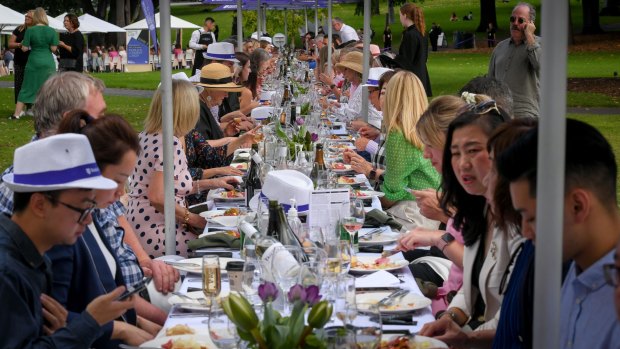By Lee Tulloch

The World's Longest Lunch in Melbourne returns in March.Credit: Eddie Jim
In the days when people could smoke in restaurants in Paris, I remember sitting at tables so close together that I had to keep moving my plate to avoid ash falling into it from the cigarette of the person next to me.
The idea of dining elbow-to-elbow with a complete stranger never really appealed to me, for reasons of privacy as well as sanitation. I always felt awkward having conversations – especially if it were about money or sex – with my chosen dining companion while the stranger next to me pretended not to tune in, or when their chatter was so loud, I could barely hear myself think.
As US talk show host Seth Myers recently joked, "It's like listening to four podcasts at once."
He was talking about communal tables at restaurants, a trend I thought would die a natural death after the pandemic. But as soon as distancing laws were dropped, tables moved back closer together, long dining tables were reintroduced, and the idea of communal feasting and coffee-imbibing really took off.
Maybe it's due to a desire to reconnect. I often hear people talking about how they've lost the art of conversation or even the basic ability to reach out to other people with a phone call. The pandemic rewired our brains to make us more introverted.
But some are making up for lost time, not only with their friends, but by seeking out the company of strangers, where there's usually more reward than risk. There's risk in finding yourself at a table dominated by an obnoxious stranger, that's true, but there's reward in opening yourself up to new stories and opinions – and perhaps friends and lovers.
Melbourne is about to hold the doozy of all communal tables once more this March when it hosts 1600 diners, sharing 600 metres of table, at The World's Longest Lunch for its annual Food & Wine Festival.
For diners before the 18th Century, dining this way (although perhaps not on such a grand scale) was the only way you ate in public. The first restaurants in Europe were eating halls and shared tables in taverns. It wasn't until 1765 that the first modern restaurant opened in Paris. It was the first establishment to serve food without a fixed schedule at individual tables and offered a choice of dishes, with the menu posted on the outside of the building.
The first communal table I came across was at the cafe Pain Quotidian in New York's Soho in the 1990s. Some of the long tables in this chain seated 20 or more and communication with your neighbour was actively encouraged – in a city like New York where people like to sticky-beak, the concept took off immediately.
After that, I came across communal tables most often at wilderness or safari lodges, where it was convivial for guests to gather at the end of the day. Chef's tables in high-end restaurants and crowded stools in Japanese ramen bars were also increasingly popular ways to socialise over food.
Years before the pandemic, hotels began to embrace the idea of community, led by forward-thinking brands such as Ace, Hoxton and Mama Shelter. Coupled with the revolution in working remotely and kicked on by a tribe of creatives who like to work on their laptops in social situations, hotels opened out their lobbies with cafes, lounge rooms and hybrid workspaces.
Many hotels now strive to be part of their local communities, welcoming neighbours, employing them in greater numbers and celebrating local art and craftsmanship.
Lobbies have mostly been gregarious places. Even so, they've often been the exclusive domain of guests and their visitors. These days, it's unusual to find a hotel that doesn't encourage a more fluid meeting space – people are attracted to buzz, and it's good for business.
Another place where communal tables are commonplace are on cruises. They're a blessing for solo travellers and have rescued me a few times when I've been alone, especially when the maître'd has been adept at matching people. Even as part of a couple, I quite like this kind of social roulette. It's not for misanthropes. But if you have an open mind and curiosity, you can share far more than food.
Despite my instinct to be private, almost every time I've sat down at a big table of strangers, I've gotten up feeling a little more a part of the human race.
Even in Paris, where I'm pleased to say they don't smoke indoors anymore.
Sign up for the Traveller Deals newsletter
Get exclusive travel deals delivered straight to your inbox. Sign up now.